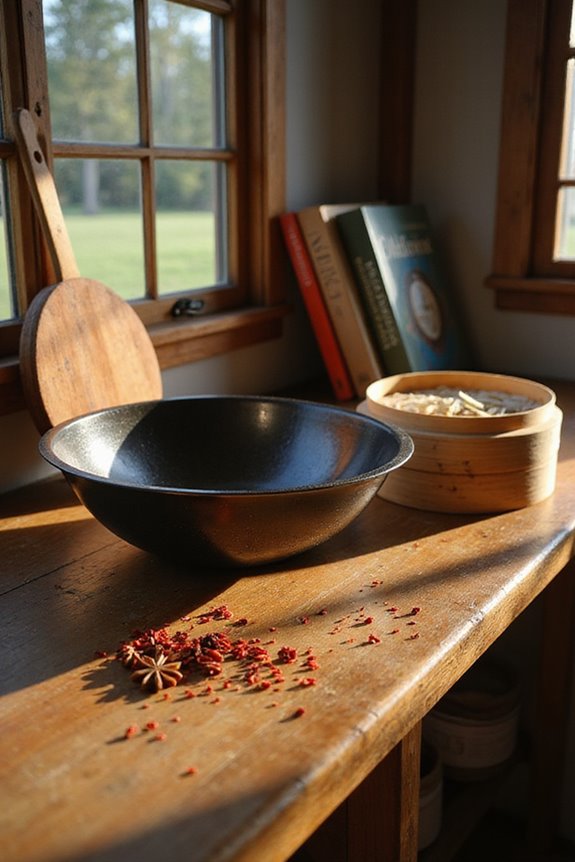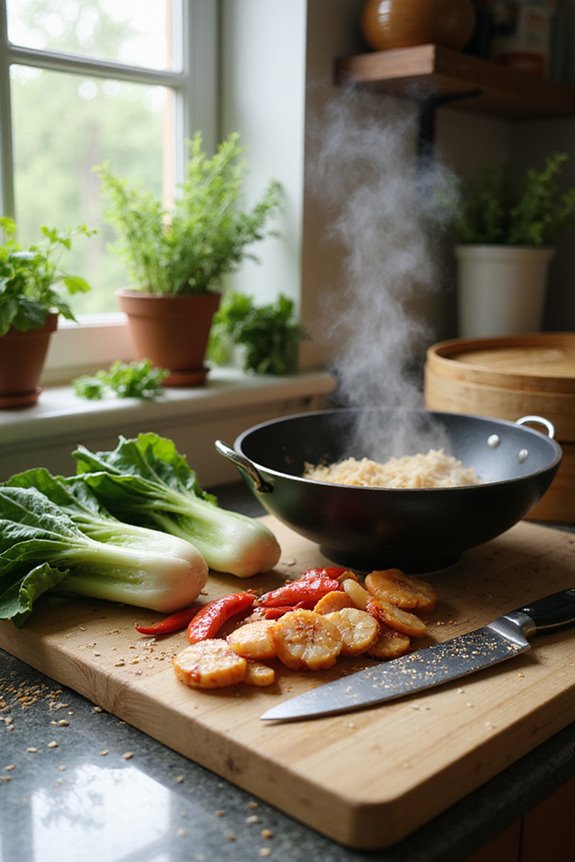As an Amazon Associate, we earn from qualifying purchases. Some links may be affiliate links at no extra cost to you. Although our opinions are based on curated research, we haven't used these products. Articles generated with AI.

5 Best Green Home Renovation Ideas to Make Your Space Sustainable and Eco-Friendly
To make your home sustainable and eco-friendly, consider upgrading to energy-efficient appliances, installing solar panels, and using non-toxic materials. Incorporating proper insulation can cut energy costs by up to 30%. You might also explore native plants in your landscaping and choose reclaimed wood for your renovations. Each choice can greatly reduce your environmental impact while enhancing your living space’s comfort. Learn about further enhancements and specific products that can optimize your renovation journey.
Key Takeaways
- Utilize sustainable materials like reclaimed wood, bamboo, and non-toxic options to minimize environmental impact and enhance durability.
- Install energy-efficient appliances and smart home technology to reduce energy consumption and lower utility bills over time.
- Enhance insulation and upgrade HVAC systems to improve energy efficiency, potentially cutting heating and cooling costs by up to 50%.
- Incorporate renewable energy sources, such as solar panels, to offset energy costs and promote sustainable living.
- Design outdoor spaces using native plants and reclaimed materials to create beautiful, low-maintenance landscapes that support local ecosystems.
Building a Sustainable Home: Practical Green Design Choices
Sale
Building a Sustainable Home: Practical Green Design Choices for Your Health, Wealth, and Soul
- Schifman, Melissa Rappaport (Author)
- English (Publication Language)
- 224 Pages - 08/21/2018 (Publication Date) - Skyhorse (Publisher)
If you’re enthusiastic to create a home that’s not only environmentally friendly but also comfortable and sustainable, “Green Home Renovation Ideas” is an excellent choice for you. Building a sustainable home requires practical green design choices that prioritize efficiency and resource conservation. Consider selecting non-toxic materials for construction and furnishings, which not only protect your health but also lower your carbon footprint. Insulating properly can reduce energy consumption, while installing energy-efficient appliances can save you money. Always evaluate the long-term sustainability of your choices, focusing on what’s feasible and beneficial for both you and the environment. Every little change counts!
Best For: Individuals looking to create an environmentally friendly and sustainable home.
Pros:
- Comprehensive coverage of various sustainable design topics.
- Engaging writing style that combines personal storytelling with factual information.
- Offers practical advice suitable for readers at any stage of their sustainability journey.
Cons:
- Contains inaccuracies regarding HVAC systems and efficiency claims.
- Lacks discussion on important concepts like thermal bridging and advanced appliances.
- May not sufficiently address the economic challenges of sustainable choices in society.
Porches and Sunrooms: Planning and Remodeling Ideas
Porches and Sunrooms: Planning and Remodeling Ideas (Creative Homeowner) Inspiration to Add a Porch,...
- Roger German (Author)
- English (Publication Language)
- 224 Pages - 10/15/2005 (Publication Date) - Creative Homeowner (Publisher)
For homeowners looking to enhance their living spaces with elegant yet functional outdoor areas, exploring the options of porches and sunrooms is a smart choice. You can create inviting spaces for relaxation, socializing, or enjoying a good book, all while boosting your home’s value. Consider enclosing a sunroom to keep it cozy year-round or designing a three-season porch for versatile use. Practical resources, like books with over 400 illustrations, can guide you through the planning process, helping you visualize projects and implement best practices for structural integrity. Many homeowners have found these ideas affordable and achievable, making them worth exploring.
Best For: Homeowners seeking inspiration and practical advice for adding porches or sunrooms to enhance their living spaces.
Pros:
- Inspiration: Offers a variety of design concepts to create relaxing and social spaces.
- Practical Guidance: Provides actionable ideas for sunroom construction that are affordable and achievable.
- Visual Aids: Contains beautiful illustrations that help in visualizing potential projects.
Cons:
- Illustration Count Discrepancy: Claims to have over 400 pictures, but some readers noted fewer illustrations.
- Limited to Specific Spaces: Focuses primarily on porches and sunrooms, which may not appeal to those looking for broader home improvement ideas.
- Potential Overwhelm: The number of ideas might be overwhelming for some readers trying to narrow down their choices.
An Introduction to Building and Renovating Houses: Volume 1
An Introduction to Building and Renovating Houses: Volume 1. Hiring Contractors, Managing...
- Netscher, Paul (Author)
- English (Publication Language)
- 247 Pages - 06/03/2019 (Publication Date) - Independently published (Publisher)
When starting on home renovations, particularly those with a green focus, you’ll find that “An Introduction to Building and Renovating Houses: Volume 1” is an excellent guide for anyone enthusiastic to enhance their living space sustainably. This thorough resource covers hiring contractors, managing construction, and precise finishing tips, catering to both DIY enthusiasts and novices alike. Many readers appreciate its clear explanations and practical approach, though some seasoned DIYers might find it less groundbreaking. Overall, this book stands out for its detailed guidance, empowering you to make informed choices while contributing to a more sustainable home environment.
Best For: This book is best for both seasoned DIY enthusiasts and newcomers looking to navigate home renovations sustainably and effectively.
Pros:
- Clear explanations make complex building and renovation concepts accessible to all levels of expertise.
- Comprehensive coverage of hiring contractors, managing construction, and finishing tips equips readers with practical knowledge.
- Focus on sustainability aligns with the growing interest in eco-friendly home improvement practices.
Cons:
- Some experienced DIYers may feel the content lacks new or innovative insights.
- Confusion exists over the relationship with the author’s other book, which may lead to questions about redundant information.
- The two-volume set might be considered lengthy for readers looking for a quick reference guide.
Green Restorations: Sustainable Building and Historic Homes
Green Restorations: Sustainable Building and Historic Homes
- New
- Mint Condition
- Dispatch same day for order received before 12 noon
Homeowners who appreciate the beauty and character of older homes will find “Green Restorations” an invaluable guide to sustainable building practices. This book highlights the benefits of rehabilitating historic homes, showing how they can be energy-efficient and durable while retaining their unique charm. Targeting both homeowners and restoration professionals, it serves as an essential resource for preserving architectural heritage. While it offers valuable insights into restoration techniques, some readers may wish for more practical, step-by-step guides. Nonetheless, the information provided can greatly inform your journey in marrying sustainability with historical preservation, ensuring that your home remains both eco-friendly and historically rich.
Best For: Homeowners who value the charm of older homes and professionals in historic restoration seeking sustainable building practices.
Pros:
- Invaluable resource for preserving older homes while promoting energy efficiency and durability.
- Offers unique insights into restoration practices that are often unknown to the general public.
- Highly recommended for those interested in historical preservation, providing valuable information for both novices and experts.
Cons:
- Some readers desire more practical, step-by-step guides for restoration processes.
- May not cater to those looking for in-depth technical manuals on specific restoration techniques.
- The focus on concepts may leave some practical applications underexplored.
Prescriptions for a Healthy House, 3rd Edition: A Practical Guide for Homeowners
Prescriptions for a Healthy House, 3rd Edition: A Practical Guide for Architects, Builders &...
- Amazon Kindle Edition
- Baker-Laporte, Paula (Author)
- English (Publication Language)
Creating a safe and healthy living environment is essential for families concerned about wellness, making the “Prescriptions for a Healthy House, 3rd Edition” an invaluable resource. This guide offers practical advice on building a home that minimizes health risks, including mold and allergens. It emphasizes using green materials that emit no VOCs, vital for eco-friendly renovations. Organized into 16 Divisions relevant to construction, it simplifies discussions with builders, regardless of your expertise. Even those with Multiple Chemical Sensitivities find it helpful, as it tackles various health issues thoroughly. Investing in this book can enhance your home’s safety and promote your family’s well-being.
Best For: Families looking to create a safe, healthy living environment, especially those concerned about allergies and health issues.
Pros:
- Provides practical guidance on building with green materials that emit no VOCs.
- Organized into 16 Divisions, making it accessible for both homeowners and contractors.
- Addresses a variety of health issues, making it beneficial for those with Multiple Chemical Sensitivities.
Cons:
- Some readers find the technical jargon difficult to understand.
- Issues reported with the Kindle version, including garbled text and poorly formatted tables.
- Limited focus on non-USA perspectives, leaving some readers wishing for additional international resources.
Factors to Consider When Choosing Green Home Renovation

When you’re planning your green home renovation, consider several key factors. Evaluating energy efficiency options, choosing sustainable materials, and sticking to your budget are essential steps. Don’t forget to think about how your design choices impact the environment while ensuring your space looks great.
Assessing Energy Efficiency Options
Evaluating energy efficiency options is essential for making informed decisions about your home renovation. Start with your home’s insulation; it can cut heating and cooling costs by up to 30% if done right. Next, look at your HVAC system; upgrading to energy-efficient models may reduce your energy usage by 20-50%. You should also consider renewable energy sources like solar panels, which can offset up to 100% of your energy costs, depending on your location. Energy-efficient windows are another smart choice, reducing heat loss by 30-50%. Finally, implementing smart home technology, such as smart thermostats, can save you around 10-12% on heating and 15% on cooling, providing valuable savings throughout the year.
Choosing Sustainable Materials
Choosing sustainable materials for your home renovation is crucial not only for the environment but also for your health and comfort. Start by prioritizing locally sourced products, which cut down on transportation emissions and support your local economy. Consider renewable options like reclaimed wood or bamboo, as these materials have a smaller carbon footprint than traditional lumber. It’s also important to choose non-toxic materials free from volatile organic compounds (VOCs) to enhance indoor air quality. Don’t forget to assess the durability and lifecycle of your choices; long-lasting materials minimize the need for replacements. Finally, look into energy-efficient options, like superior insulation, to improve thermal performance and lower your long-term energy consumption.
Budgeting for Renovation Costs
Budgeting for green home renovations involves careful planning to guarantee you’re making wise financial decisions. Start by considering the potential upfront costs of sustainable materials, which can lead to long-term savings on energy bills. Don’t forget to allocate funds for an extensive energy audit; this can pinpoint areas needing improvement and help prioritize your renovation efforts effectively. Look into incentives, rebates, or tax credits for energy-efficient upgrades; these can greatly reduce renovation costs. It’s also wise to plan for unexpected expenses; setting aside 10–20% of your budget can act as a safety net. Finally, conduct thorough research and compare green alternatives to balance initial costs with long-term benefits, ensuring a financially sound renovation.
Considering Design Aesthetics
When starting a green home renovation, it’s essential to contemplate design aesthetics that align with sustainability goals. Focus on harmonizing sustainable materials with your home’s architectural style for enhanced visual appeal. Consider incorporating strategic window placements and skylights to maximize natural light, reducing your reliance on artificial lighting. Opt for a color palette inspired by nature, which not only beautifies your space but fosters a calming atmosphere linked to biophilic design. Using reclaimed or recycled materials adds unique character and showcases your commitment to sustainability. Finally, don’t forget about landscaping—integrate native plants that require less water and maintenance to complement your eco-friendly renovation efforts, blending outdoor and indoor environments seamlessly.
Evaluating Environmental Impact
As you commence on your green home renovation, it’s important to evaluate the environmental impact of your choices to guarantee they align with your sustainability goals. Start by examining the lifecycle carbon footprint of your materials; some renewable options might harm the environment during extraction. Next, focus on energy-efficient renovation techniques, like proper insulation, which can cut energy consumption by up to 30%. Also, consider water usage and aim for solutions minimizing waste, promoting sustainable practices. Analyze how you can reduce waste through material reuse or recycled content to lower landfill contributions. Finally, investigate how your renovations could affect local ecosystems, ensuring you don’t disrupt habitats or contribute to pollution in surrounding areas.
Engaging Professional Expertise
Choosing the right professionals for your green home renovation isn’t just a matter of finding someone with a toolbelt; it’s about selecting experts who understand sustainable practices and can integrate them seamlessly into your project. Look for contractors experienced in green building; they’ll provide insights on the latest materials and technologies that enhance your home’s performance while minimizing environmental impact. Additionally, skilled professionals can help you navigate complex regulations and building codes, ensuring compliance and avoiding costly mistakes. They’ll conduct thorough assessments of your existing structures, identifying opportunities to improve energy efficiency. By collaborating with these experts, you’ll achieve innovative design solutions that blend sustainability naturally with your home’s aesthetics and functionality. Don’t underestimate their value in transforming your space.
Frequently Asked Questions
What Are the Costs Associated With Green Home Renovations?
When considering green home renovations, you’ll find costs can vary widely. Energy-efficient windows might cost between $300 to $1,000 each, while solar panels typically range from $15,000 to $25,000, depending on the size of your home. Recycled materials can be budget-friendly, but high-quality insulation and sustainable flooring may add extra expense. Ultimately, it’s crucial to plan your budget carefully, as the long-term savings on utility bills can offset initial investments over time.
How Can I Find Eco-Friendly Materials for My Project?
To find eco-friendly materials for your project, start by researching local suppliers specializing in sustainable options. Look for reclaimed wood, bamboo, or recycled metal. Websites like Green Building Supply and Eco-Building are great resources. Visit local salvage yards for unique finds, and check certifications like FSC or Energy Star when purchasing materials. Networking with contractors experienced in green building can also yield valuable recommendations. Don’t forget to compare prices for the best deals.
Are There Tax Incentives for Green Renovations?
Yes, there are tax incentives for green renovations that can reduce your costs. Many federal and state programs offer credits for using energy-efficient appliances or solar panels. You might also find local rebates for improvements like insulation or smart thermostats. To maximize those savings, keep receipts and check eligibility requirements. It’s a good idea to consult with a tax professional, ensuring you take full advantage of the available incentives for your renovations.
Can I Renovate My Home in Stages Sustainably?
Yes, you can renovate your home in stages sustainably. Start with the most essential areas, like insulation or windows, focusing on energy efficiency. Choose eco-friendly materials that align with your budget. For example, consider reclaimed wood and low-VOC paints. Each stage’s improvements can contribute to a smaller carbon footprint. Plus, you’ll reduce disruption by completing one section at a time, allowing you to enjoy your space throughout the process.
How Do I Choose a Qualified Green Contractor?
Choosing a qualified green contractor can feel intimidating, but a focused approach simplifies it. Start by seeking references from sustainable sources, like local eco-friendly builders or environmental organizations. Check certifications that verify expertise in green practices, and ask for detailed project portfolios demonstrating successful eco-renovations. Finally, conduct interviews to gauge their commitment to sustainability—effective communication is key. You’ll guarantee your renovation aligns with eco-friendly principles by following these steps!









